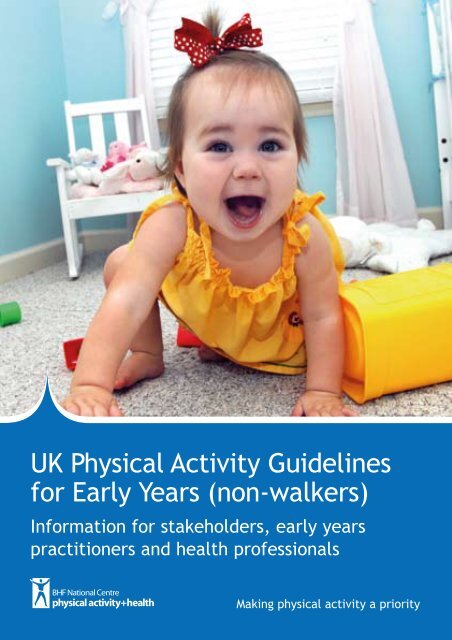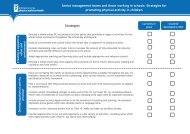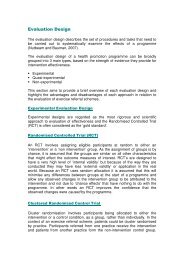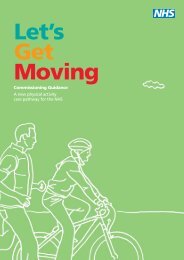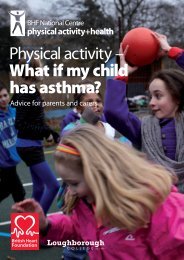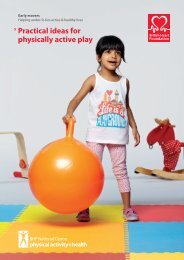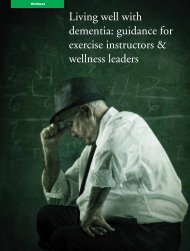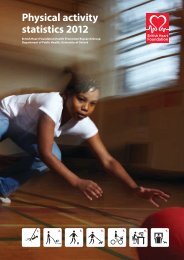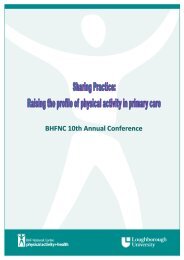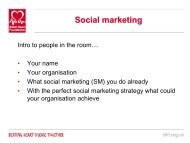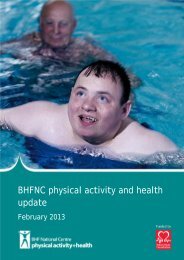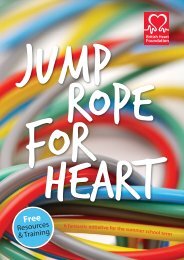UK Physical Activity Guidelines for Early Years - BHF National ...
UK Physical Activity Guidelines for Early Years - BHF National ...
UK Physical Activity Guidelines for Early Years - BHF National ...
You also want an ePaper? Increase the reach of your titles
YUMPU automatically turns print PDFs into web optimized ePapers that Google loves.
<strong>UK</strong> <strong>Physical</strong> <strong>Activity</strong> <strong>Guidelines</strong><br />
<strong>for</strong> <strong>Early</strong> <strong>Years</strong> (non-walkers)<br />
Costs of<br />
<strong>Physical</strong> Inactivity<br />
In<strong>for</strong>mation <strong>for</strong> stakeholders, early years<br />
practitioners and health professionals<br />
Making physical activity a priority
<strong>UK</strong> <strong>Physical</strong> <strong>Activity</strong> <strong>Guidelines</strong> <strong>for</strong> <strong>Early</strong> <strong>Years</strong> (non-walkers)<br />
<strong>Early</strong> years settings play a key role in providing enabling environments<br />
which can contribute towards helping young children achieve the daily<br />
physical activity requirement <strong>for</strong> their health and well-being.<br />
The <strong>Early</strong> <strong>Years</strong> <strong>Physical</strong><br />
<strong>Activity</strong> <strong>Guidelines</strong><br />
The introduction of <strong>UK</strong> early years physical activity<br />
guidelines reflect a growing awareness of their<br />
importance and follows the lead of other major<br />
international countries. They are based on evidence<br />
from research and the combined input from experts in<br />
this field of study.<br />
These guidelines are relevant to all children under the<br />
age of five and are aimed at the following groups:<br />
<strong>Early</strong> years (under fives) –<br />
Infants who cannot yet walk unaided:<br />
<strong>Physical</strong> activity should be encouraged<br />
from birth, particularly through floorbased<br />
play and water-based activities in<br />
safe environments.<br />
Pre-school children who can<br />
walk unaided:<br />
Children of pre-school age who are<br />
capable of walking unaided should be<br />
physically active daily <strong>for</strong> at least 180<br />
minutes (3 hours), spread throughout<br />
the day.<br />
Sedentary guideline:<br />
All under fives should minimise the<br />
amount of time spent being sedentary<br />
(being restrained or sitting) <strong>for</strong><br />
extended periods (except time spent<br />
sleeping).<br />
Why do we need physical<br />
activity guidelines <strong>for</strong><br />
the early years?<br />
There has been a growing concern in<br />
recent years about a lack of physical<br />
activity and increased sedentary behaviour<br />
among young children. Children under<br />
five have not previously been included
in <strong>UK</strong> public health guidelines and those<br />
devised <strong>for</strong> the 5-18 age group are neither<br />
suitable nor appropriate <strong>for</strong> most under<br />
fives. Children under five need time to play<br />
and master their physical environment and<br />
develop fundamental movement skills.<br />
The importance of<br />
physical activity <strong>for</strong><br />
children in the early years<br />
During the period from birth to five years,<br />
physical activity is critical to optimal growth<br />
and development. During this time babies<br />
and young children undergo rapid and<br />
wide-ranging physical and psychological<br />
developments which lay the foundation <strong>for</strong><br />
their future health and well-being.<br />
The early years is also an important time in<br />
the establishment of physical activity and<br />
sedentary behaviours. Data from tracking<br />
studies show support <strong>for</strong> a link between<br />
higher levels of physical activity leading<br />
to more sustained participation in physical<br />
activity in later years. There<strong>for</strong>e it is<br />
important to establish a high level of activity<br />
at the earliest age, in order to provide the<br />
best start to encourage activity patterns and<br />
habits later in childhood that are sufficient<br />
to benefit long term good health.<br />
At no other point will children learn so many<br />
physical skills as they do in the first five<br />
years of life! The benefits of young children<br />
being physically active go way beyond just<br />
the physical benefits. Research has shown<br />
<strong>UK</strong> <strong>Physical</strong> <strong>Activity</strong> <strong>Guidelines</strong> <strong>for</strong> <strong>Early</strong> <strong>Years</strong> (non-walkers)<br />
that being physically active can help with<br />
the development of:<br />
• Motor skills eg balance, coordination<br />
• Maintaining a healthy weight<br />
• Strong bones, muscles and heart<br />
• Social skills ie how to interact, take<br />
turns and getting on and caring about<br />
others.<br />
It is also widely believed that physical<br />
activity can help with the development of:<br />
• Self confidence<br />
• Communication skills including how to<br />
solve problems and make decisions<br />
• Establishing good habits <strong>for</strong> being<br />
active so will they will continue to<br />
be active throughout the rest of their<br />
childhood and beyond.<br />
• Developing important brain structures.<br />
• Developing immediate and long-term<br />
good health outcomes.<br />
How do the guidelines<br />
reflect differences in the<br />
under five population?<br />
‘Under fives’ encompass a diverse range<br />
of children from new-borns through<br />
to children about to start school. As<br />
developmental rates can vary a great<br />
deal in children of the same age, the<br />
key distinction to make between the two<br />
guidelines is there<strong>for</strong>e between those not<br />
yet able to walk and those who can.<br />
Making physical activity a priority
<strong>UK</strong> <strong>Physical</strong> <strong>Activity</strong> <strong>Guidelines</strong> <strong>for</strong> <strong>Early</strong> <strong>Years</strong> (non-walkers)<br />
The importance of<br />
movement <strong>for</strong> infants not<br />
yet walking<br />
Unrestricted floor-based activities in the<br />
home and early years settings are an<br />
essential source of physical activity <strong>for</strong><br />
infants not yet walking and are important<br />
<strong>for</strong> helping them to:<br />
• Maintain a healthy weight<br />
• Build social and emotional bonds with<br />
parents, siblings and other children<br />
• Develop good posture, strength and<br />
balance<br />
• Develop all their senses<br />
• Teach them about their bodies and the<br />
world around them<br />
• Interact with others and develop<br />
language and communication skills<br />
• Keep their bodies and minds active.<br />
Tummy time (any time when babies are<br />
carried, positioned or played with on their<br />
stomachs), plays a critical role in enabling<br />
babies to develop sensory, visual and<br />
movement control, helping to strengthen<br />
the muscles in the legs, arms, back and<br />
neck and to establish head control. This<br />
eventually helps babies to push up, roll<br />
and move into a crawling position and in<br />
turn helps develop shoulder stability, hand<br />
strength and coordination – all important<br />
<strong>for</strong> later movement skills including writing<br />
development. Muscles developed in the<br />
neck during head control are important<br />
<strong>for</strong> the development of speech and<br />
language skills.<br />
What types of physical<br />
activity are appropriate<br />
<strong>for</strong> infants not yet<br />
walking?<br />
Babies from when they are first born need<br />
to have daily opportunities to move freely<br />
on their stomach, or back in a variety of<br />
stimulating, safe spaces, without being<br />
constrained <strong>for</strong> long periods by clothing,<br />
wraps, straps (ie in car seats or baby chairs<br />
or bouncers). They need opportunities<br />
to practise important movements such<br />
as: reaching <strong>for</strong> and grasping objects;<br />
turning the head toward stimuli; pulling;<br />
pushing and playing with other people,<br />
objects and toys.
Appropriate water-based activities<br />
with parents or carers, provide similar<br />
opportunities <strong>for</strong> movement and are<br />
recommended.<br />
For more in<strong>for</strong>mation about the types<br />
of physical activities under fives<br />
who are walking should be doing to<br />
benefit their health, download the<br />
factsheet <strong>for</strong> ‘Walkers.’<br />
Tips <strong>for</strong> promoting<br />
more physical activity<br />
and reducing sedentary<br />
behaviour in an early<br />
years setting<br />
Increasing movement by:<br />
Creating spaces<br />
• Provide lots of soft areas both inside<br />
and outside to encourage babies,<br />
placed on their fronts and backs to use<br />
large muscle groups, (without being<br />
restrained by clothing), to kick, roll,<br />
crawl, pull up to standing position,<br />
creep and finally walk.<br />
• Play spaces need to encourage young<br />
children to learn these new movements<br />
and they need plenty of time<br />
throughout the day to practise these.<br />
• Outdoor play is important to help<br />
babies experience and learn about<br />
different surroundings.<br />
<strong>UK</strong> <strong>Physical</strong> <strong>Activity</strong> <strong>Guidelines</strong> <strong>for</strong> <strong>Early</strong> <strong>Years</strong> (non-walkers)<br />
Using sensory toys/objects<br />
• Provide lots of sensory, tactile,<br />
colourful and interesting ageappropriate<br />
toys/objects to stimulate<br />
baby’s natural curiosity, this will<br />
encourage movement and develop<br />
their recognition of touch.<br />
• Objects placed out of reach will<br />
encourage babies to move towards<br />
them.<br />
• Moving objects that babies can follow<br />
with their eyes, reading books to<br />
them or placing them under colourful<br />
mobiles or play gyms will help<br />
develop eye strength and encourage<br />
movement.<br />
• Once babies are moving, use tunnels<br />
<strong>for</strong> them to crawl through, cushions<br />
to climb over and sturdy structures to<br />
pull up on.<br />
Making physical activity a priority
<strong>UK</strong> <strong>Physical</strong> <strong>Activity</strong> <strong>Guidelines</strong> <strong>for</strong> <strong>Early</strong> <strong>Years</strong> (non-walkers)<br />
Allowing lots of opportunities <strong>for</strong><br />
‘tummy time’<br />
• Very young babies can find it difficult<br />
to tolerate this position as they are<br />
unused to it, so distraction and ‘little<br />
and often’ are the best approaches to<br />
adopt.<br />
• Get down on the floor with baby, place<br />
age-appropriate toys around baby that<br />
encourage grasping, leg kicking and<br />
head lifting.<br />
Remember ‘tummy time’ is only <strong>for</strong><br />
when babies are awake and supervised.<br />
Babies should always be placed on their<br />
backs to sleep.<br />
Interacting with baby<br />
• Get down on the floor with baby. Talk,<br />
smile, interact and play with baby<br />
using simple toys and everyday objects,<br />
this will stimulate their senses and<br />
encourage them to move.<br />
Using noise<br />
• Noise during play can help with areas<br />
of brain development and encourage<br />
movement eg rattles, noisy toys such<br />
as wooden spoons and saucepans,<br />
playing music, singing songs and<br />
nursery rhymes.<br />
Working with parents and carers<br />
• Parents and carers should be made<br />
aware of the importance of providing<br />
regular unrestricted movement<br />
opportunities and restricting sedentary<br />
time where possible (apart from<br />
sleeping) <strong>for</strong> the child or children in<br />
their care.<br />
• Babies love to be around people and<br />
learn a lot from interacting with them.<br />
It is there<strong>for</strong>e important that parents/<br />
carers make time to interact with their<br />
baby, including playing with them.<br />
Coming soon...Leaflets <strong>for</strong> parents<br />
full of ideas <strong>for</strong> physical activity with<br />
their baby. Keep an eye on<br />
www.bhfactive.org.uk <strong>for</strong> details.<br />
• Providing ‘take-home bags’ which<br />
include a variety of small equipment,<br />
everyday objects and cards with<br />
activity ideas, can be a useful way of<br />
encouraging parents to stimulate active<br />
play with their child at home.<br />
• Encourage parents to send children<br />
prepared to play out in all weathers eg<br />
wellies, warm coat, hat, scarf and gloves<br />
<strong>for</strong> winter months; sunhats, sun creams,<br />
thin long-sleeved tops <strong>for</strong> summer<br />
months. This could be incorporated into<br />
the setting’s physical activity policy.<br />
Settings could provide a box of spare<br />
clothes (collected from charity shops)<br />
<strong>for</strong> those children whose parents may<br />
<strong>for</strong>get. Providing a covered area such as<br />
a gazebo can help to provide some shady<br />
areas to play in the summer.
Sedentary behaviour<br />
There is evidence that under fives spend<br />
a large amount of time being sedentary<br />
and this is associated with overweight<br />
and obesity as well as lower cognitive<br />
development. Sedentary behaviour refers<br />
to activities that typically occur whilst<br />
seated or lying down and which require<br />
very low levels of energy expenditure.<br />
In addition, patterns of sedentary<br />
behaviour, (especially TV viewing)<br />
established in the early years are<br />
more likely to be continued through to<br />
adulthood. It is important there<strong>for</strong>e to<br />
establish healthy behaviours in the early<br />
years in order to protect their health<br />
against possible less healthy behaviour in<br />
the future.<br />
It’s true that nowadays there are many<br />
opportunities <strong>for</strong> young children to spend<br />
excessive time in sedentary behaviour<br />
such as watching television, travelling<br />
<strong>UK</strong> <strong>Physical</strong> <strong>Activity</strong> <strong>Guidelines</strong> <strong>for</strong> <strong>Early</strong> <strong>Years</strong> (non-walkers)<br />
Patterns of sedentary behaviour<br />
established in the early years<br />
are more likely to be continued<br />
through to adulthood<br />
by car, sat in a buggy or sitting whilst<br />
playing games. Even <strong>for</strong> babies, being<br />
restrained <strong>for</strong> longer periods of time than<br />
is necessary, is not good <strong>for</strong> their health as<br />
it limits the opportunities <strong>for</strong> movement.<br />
All children need quiet ‘down time,’<br />
however reducing these sedentary times,<br />
breaking up extended periods of sitting<br />
and replacing them with more active<br />
options, is strongly advised <strong>for</strong> children in<br />
the early years.<br />
Reduce sedentary behaviour by:<br />
• Reducing time spent in walking aides<br />
or baby bouncers (these limit free<br />
movement)<br />
• Interacting with infants regularly – this<br />
encourages movement<br />
• Making parents and carers aware of<br />
the benefits of reducing their baby’s<br />
time spent infant carriers, high chairs<br />
and car seats and increasing their<br />
opportunities <strong>for</strong> free movement.<br />
Making physical activity a priority
<strong>UK</strong> <strong>Physical</strong> <strong>Activity</strong> <strong>Guidelines</strong> <strong>for</strong> <strong>Early</strong> <strong>Years</strong> (non-walkers)<br />
<strong>Physical</strong> activity resources<br />
to help promote<br />
movement and reduce<br />
sedentary behaviour<br />
Chief Medical Officers Report 2011<br />
(Department of Health)<br />
‘Start Active, Stay Active’ updates the<br />
existing guidelines <strong>for</strong> children, young<br />
people and adults, and includes <strong>for</strong> the<br />
first time in the <strong>UK</strong>, new guidelines <strong>for</strong><br />
early years and older people. Available to<br />
download at www.dh.gov.uk/publications<br />
Start4Life and Play4Life<br />
(Department of Health)<br />
The early years section of the Department<br />
of Health’s (DH) Change4Life campaign,<br />
aimed at healthcare and childcare<br />
professionals. Active play resources are<br />
available which can be downloaded and/or<br />
ordered from the DH’s orderline<br />
www.orderline.dh.gov.uk or click on<br />
www.dh.gov.uk (search Start4Life).<br />
Learning, Playing and Interacting:<br />
Good practice in the <strong>Early</strong> <strong>Years</strong><br />
Foundation Stage<br />
A toolkit to support early years practitioners’<br />
work with advice on pedagogy, practice and<br />
assessment. Available to download at: www.<br />
nationalstrategies.standards.dcsf.gov.uk/<br />
earlyyears<br />
Get Up and Grow (Australian Government<br />
Department of Health and Ageing)<br />
A series of four downloadable booklets<br />
and leaflets specifically written <strong>for</strong> early<br />
Published by<br />
British Heart Foundation <strong>National</strong> Centre (<strong>BHF</strong>NC)<br />
<strong>for</strong> <strong>Physical</strong> <strong>Activity</strong> and Health, Loughborough University<br />
T: 01509 226421 F: 01509 226420<br />
www.bhfactive.org.uk<br />
years managers, practitioners and families<br />
which give lots of in<strong>for</strong>mation and ideas<br />
<strong>for</strong> promoting physical activity and healthy<br />
eating <strong>for</strong> the early years. Available to<br />
download at: www.health.gov.au (search<br />
‘Get up and Grow’).<br />
Active Start, ages 0-6 (Canadian Sport <strong>for</strong><br />
Life) www.canadiansport<strong>for</strong>life.ca<br />
Offers a number of downloadable<br />
factsheets <strong>for</strong> parents and an online DVD<br />
on the importance of physical activity in<br />
the first six years of life and lots of activity<br />
ideas relevant to the different stages of a<br />
baby and young child’s development.<br />
http://www.canadiansport<strong>for</strong>life.ca/<br />
default.aspx?PageID=1004&LangID=en<br />
Artie’s Olympics (British Heart<br />
Foundation) www.bhf.org.uk/schools<br />
An activity-based fundraising scheme <strong>for</strong><br />
young children, aimed at nurseries and<br />
other groups working with the 3-8 year old<br />
age group. It encourages children to get<br />
active through a number of games<br />
and activities. Groups get to keep 20% of<br />
funds raised.<br />
Start to Play (Youth Sport Trust)<br />
www.youthsporttrust.org<br />
Aimed at those engaging with children<br />
between 0 and 5 years old, Start to<br />
Play provides a number of resources to<br />
encourage play and physical activity<br />
opportunities <strong>for</strong> young children, their<br />
parents, guardians and carers. Available to<br />
order at: www.ystdirect.org.uk Training is<br />
also available, although not compulsory,<br />
call: 01509 226600.<br />
supported by<br />
T46107/DPS/JULY11


